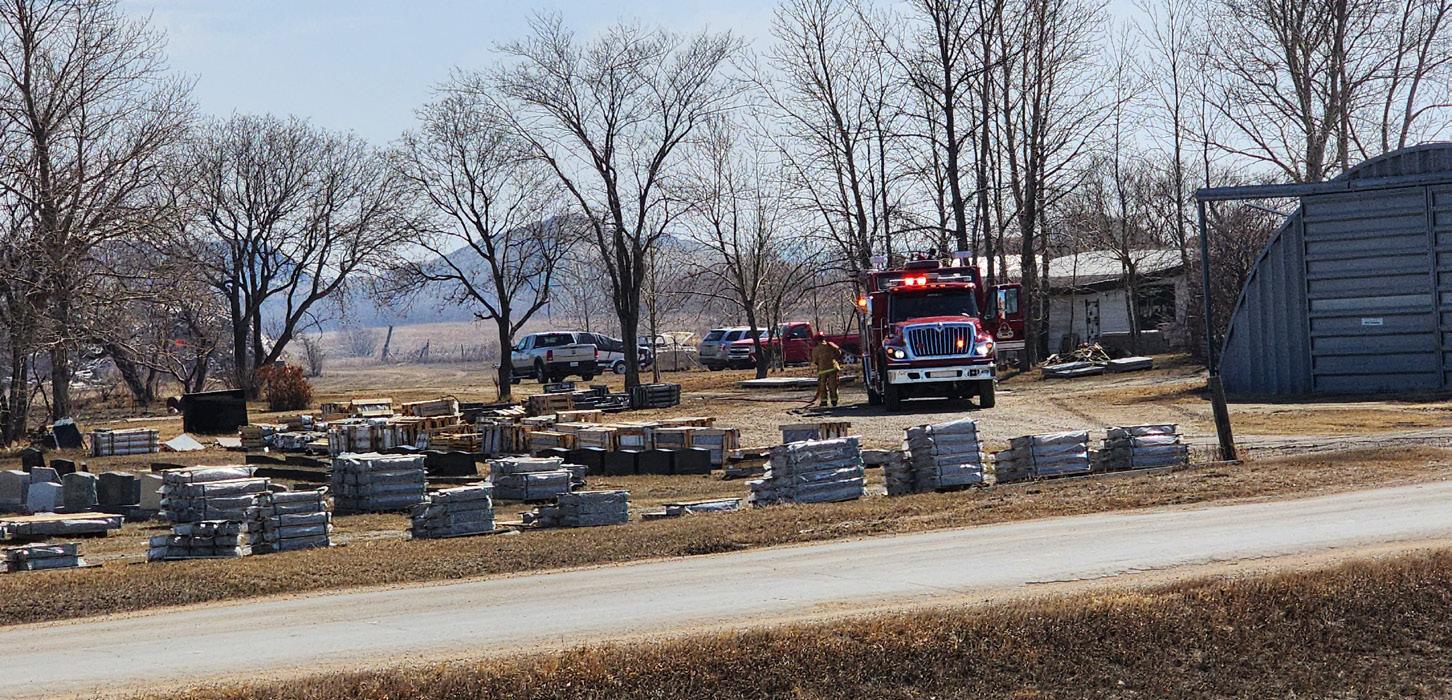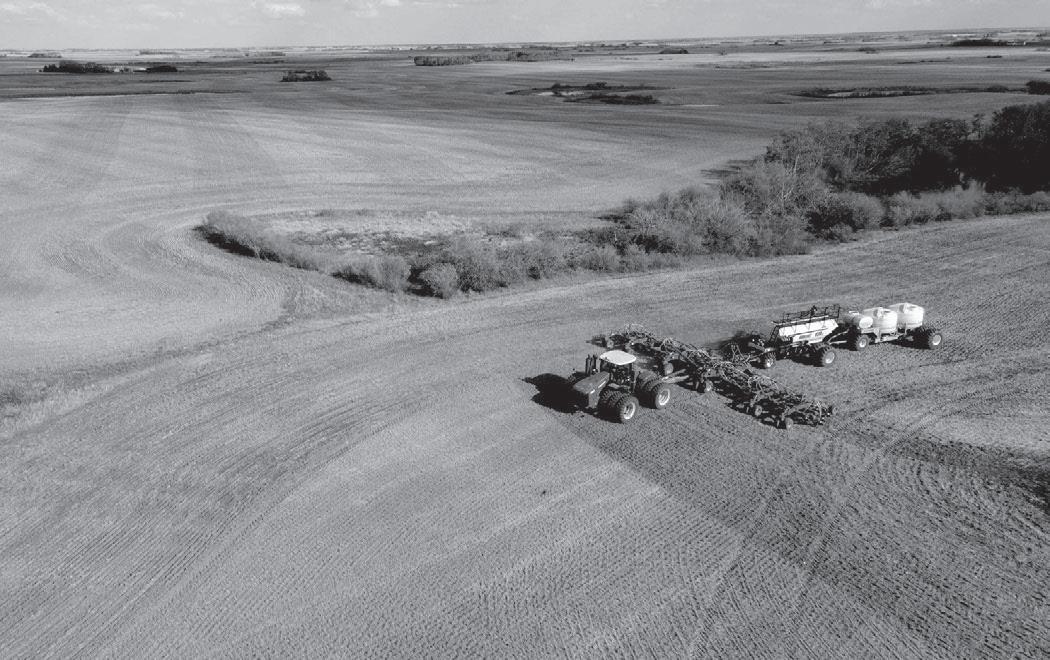
6 minute read
Fire Chief Reminds Public to Use Caution Following Highway 12 Grassfire
Shanine Sealey, Martensville Messenger
Martensville Fire Department received a call at approximately 10:50am on Monday, April 17th regarding a wildfire that was located south of Martensville near Township 381, alongside Highway 12 in the RM of Corman Park.
Advertisement
Once arriving on scene, Martensville Fire Chief Kurt Dyck noted that they decided to call in Warman Fire Rescue for back-up, as the strong winds were playing a factor and causing the fire to spread rapidly. Between the two fire departments, a total of approximately eight emergency vehicles were on scene to help tackle the fire, including numerous grass trucks, tankers, a pump truck and utility vehicles.
“The grass was dry, but the temperature was still low enough that it wasn’t as bad as it could have been had it been hotter out. Had the circumstances been any different, with that wind in play, we could have really been in trouble,” Dyck said.
RCMP were also on scene ensuring motorists were avoiding the area so the fire crews could work. The RCMP also notified the public to avoid the area if possible, as smoke from the fire was causing low visibility within the area.
The fire was under control at approximately 1:20pm, and afterwards, crews continued to work on hot spots until around 3:30pm. In total, the fire burned about ten acres of land, and no buildings or structures were affected due to the blaze and no injuries reported.
Dyck stated that they do not know the exact cause of the fire, but said that this time of year, as the ground becomes more dry with warming temperatures, it is important to take extra caution to avoid situations like this, reminding people to ensure their smoking material is extinguished properly.
What
306.665.1766
– Fundholders Jonathan, Andrea, and family

Isaiah Gauthier Wants to Become Next Blind Hockey Star
Article by Sask Sport


Isaiah Gauthier was living out his dream, skating in an arena that was once home to his favourite hockey team – the Toronto Maple Leafs.
The nine-year-old Martensville product recently went to the Canadian National Blind Hockey Tournament held at the Toronto’s Mattamy Athletic Centre – formerly known as Maple Leaf Gardens.

“It was so fun,” said Isaiah. “The people there were so kind.”
The tournament featured 165 participants from four countries and 11 provinces, competing in six divisions, marking the largest turnout in event history.
“It’s nice to see that there’s an organization that he can go into that also has the ability to grow,” said Isaiah’s mom Renelle.
And that wasn’t always the case for the Gauthiers. Isaiah was born with Leber Congenital Amaurosis – or LCA – which means he has some light perception and he can see some shadowing but no colour. Isaiah relies on his braille skills for learning and his cane skills for mobility, so playing hockey wasn’t necessarily the first thing Renelle thought he would be interested in. But Isaiah was determined to play.
“We started (skating), like everybody starts, with a pusher but he did not want to do that very long,” said Renelle. “He could skate at a very young age without the support of that. He just wanted to strive for independence.”
“And score some goals,” Isaiah chimed in.
The concept of blind hockey is the same as ablebodied hockey, but some of the rules have been adapted. Isaiah, being an avid hockey fan and hockey history buff, was quick to explain the differences.
“First of all, regular hockey nets are four feet tall. These hockey nets are three feet tall,” he said. “And you can’t shoot when you cross the blueline unless you pass at least once. Once you pass the puck, the refs blow a special whistle to indicate you can shoot and to tell the goalie the puck may be coming.”

Isaiah also explained how the puck is threetimes the size of a regular hockey puck. It’s made of thin steel and has eight ball bearings inside, which makes a distinct sound that players can hear when it’s moving. The goalie also has to wear a blindfold or be completely blind.
Back home in Saskatchewan, Isaiah has also been involved in many blind hockey events around Saskatoon, which are tremendously supported by people in the area. And being involved with families in similar situations is something Renelle has certainly appreciated.
“The community is beautiful,” said Renelle. “It takes a village to raise a child and it also takes a village to be able to help the parents navigate how to best provide for that child.”
In fact, Renelle notes that early on, there were times she didn’t know what participation in sport would look like for Isaiah. But once again, members of the community helped navigate – and support – Isaiah and his family.
“I prayed so much that people would just truly love Isaiah for who he is and encourage him,” said Renelle. “We can believe in our kids and encourage them as much as possible but when that village becomes part of our family unit, the sky is the limit.”
And after participating in his most recent tournament, Isaiah has set some personal goals in the sport.
“He said ‘I’m going to be the next blind hockey Gretzky,’” said Renelle.
And given his determination, that very well could happen. But what’s important for the Gauthiers is that Isaiah is able to be involved in a sport he truly loves.
“It’s a dream come true for us,” said Renelle. “It gives him an opportunity to be like every other boy.”
Abandoning RCMP Depot Training a Bad Idea
It’s been less than two years since RCMP Constable Shelby Patton was killed on a street in Wolseley in a hit and run after a routine traffic stop. The Yorkton-born and raised constable was just 26-years-old. The Indian Head detachment was his second posting after one on Parliament Hill after graduating from the RCMP Depot in Regina.
Yet in his short time in Indian Head, Patton made a lasting impression to his community - so much so that there is now a Memorial Park in his honour.
It says much about how we truly value the work and sacrifice of the RCMP. We all need to keep officers like Shelby Patton in mind as we consider the response to an even bigger tragedy - the 2020 death of RCMP Constable Heidi Stevenson and 21 others in and around Portapique, Nova Scotia that became the sight of the country’s biggest mass murder.
There are lessons to be learned from what started as a domestic violence situation and escalated. As pointed out the wide-ranging Mass Casualty report, we need to improve communication on the scene - both among RCMP officers and the community at-large that fell victim to the deranged gunman.
More training is likely required to recognize those that are a threat to community. Situations involving actual or threatened domestic violence must be taken more seriously. And in that vein, perhaps we do need laws that restrict or prohibit access to guns among those who are a threat to others or even themselves, but it’s also about here where the recommendations in response to the April 2020 Nova Scotia massacre that further calls for more restrictive gun laws in this country before everyone begins to go too far.
Included in those recommendations is a call to disband the 26-week training program at RCMP Depot in Regina and replace it with university-based training across the country in a model that emulates Finland.
Is that really what we need in places like rural Saskatchewan where the realities are quite different than Finland? Would this necessarily have prevented the Portapique tragedy or even the tragedy that led to Shelby Patton’s death?
Perhaps what happened in Nova Scotia is a wakeup call that tells us a 26-week RCMP Depot training does need to be enhanced. It doesn’t seem enough time to prepare young men and women for the complexities of modern-day policing … although it seems unlikely the authors of the Mass Casualty report spend all that much time examining how Depot training has dramatically changed in the last 30 years.
What goes on at Regina Depot is far removed from even what now-retired officers went through the Regina academy a few decades back when training was more about fitness than community policing.
“It’s a living, breathing thing. Every single day, we make adjustments,” Christine Hudy, director of training program support and evaluation, said in an interview last year. Hudy explained a “switch was flipped in the mid-1990s” when the emphasis moved to situational-based problem solving and more emphasis on community policing.
Does more need to be done? Absolutely. But this is still about policing. More sociology training alone is clearly not the answer. As someone noted, you don’t call someone with a sociology degree when someone is breaking into your home.
This is not to say that RCMP cadets would clearly benefit from more classroom training that probably cannot be accommodated in a 26-week training course, but we can clearly do both in Regina.
Does it not make more sense to have enhanced training for cadets at the University of Regina or First Nations University of Canada to be a far better solution?
We owe officers like Shelby Patton the best tools available to do their jobs, but mostly, we owe it to ourselves to ensure we are all protected.



